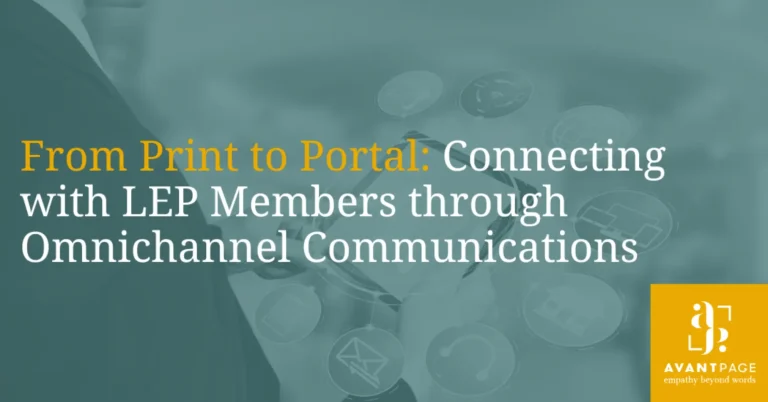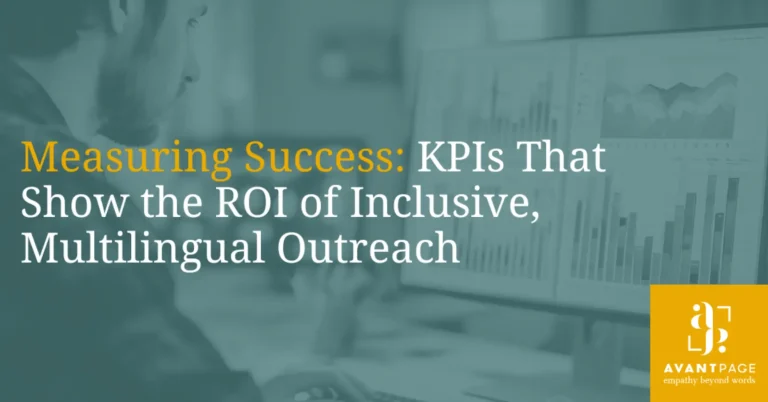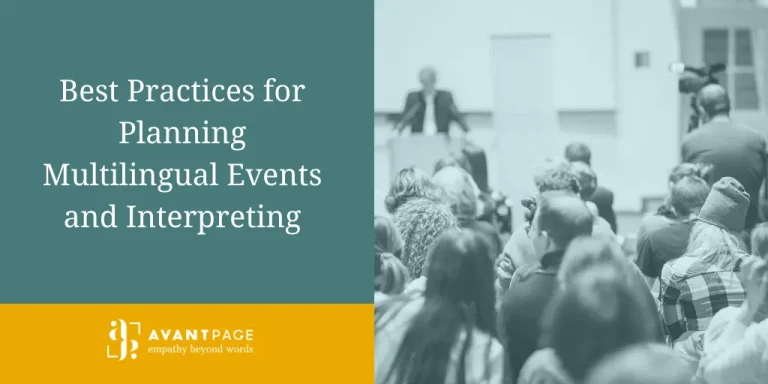Low-Cost vs. Best Value Procurement for Language Services
In government agencies, procurement (also known as purchasing) can choose between different types of bidding for proposals (RFPs) from vendors for their services. A low-cost bid looks only at the cost of a service and no other factors. With a best-value RFP, the government employee requests information about important components for that service and then scores the RFP based on their value to select the winning bid.
While a low-cost RFP gets the job done for the lowest prices, it can come with risks. It’s important to ask the right questions and know what to look out for. It’s also important to understand how to weigh evaluations and the risks when choosing low-cost over best value. It can be tricky when procurement officials manage the RFP process across many services since each one is unique and has different requirements. We made this quick guide that you can share with local procurement for language services to help them navigate the RFP process for language services.
The Risks of Low-Cost Language Services
There are risks to understand with low-cost language services. Bidders for low-cost bids are going to need to cut costs to provide competitive prices. Usually, those cuts will be seen in quality, time or management. As a result, low-cost RFPs become “a race to the bottom,” which puts pressure on the language service industry to provide quality services at a sometimes unreasonable price. Language service providers do this in a variety of ways:
- Reduce overhead costs by paying overworked employees less than they’re worth.
- Use employees with less experience.
- Pay professional linguists less than their value.
- Reduce costly security protocols.
- Add hidden fees that lead customers to get unexpected bills.
- Bid too low, resulting in an inability to cover assignments as the LSP may not have the expertise in a service or experience in a language area.
Low-cost bids can also be risky for a variety of reasons.
- The uncertainty of not knowing why the bid was low in the first place.
- If the winning business didn’t provide enough transparency and can’t continue the contract due to too few resources or other complications, the government agency will have to reissue the RFP.
- If not all of the necessary information came in from the LSPs, not enough LSPs bid or there was a mistake in the RFP, you may need to issue a costly emergency RFP.
- Low-cost bids have the potential for lawsuits for a variety of reasons. Due to the type of information in a request for a low-cost bid, an LSP may make the best effort to meet those needs but still result in language services that don’t meet the audiences’ preferences. For example, the foundation of this case in Georgia is about not providing sign language interpreters and other communication access to those who are going through the judicial system.
- The type of translation that a language service provider plans to use. For example, machine translation, a type of translation service where software translates content, is a way to reduce costs. Machine translation may work for certain types of documents where the quality doesn’t need to be high, such as internal or non-vital documents. However, if the content is public-facing or needs HIPAA compliancy, then machine translation won’t necessarily be the best choice.
- Some research suggests that if the pricing is more than 5% different between vendors, the bidding process isn’t comparing apples to apples, and the pricing structure may be unreliable. The Advantages of Best-Value Bids A best-value bid has a lot of benefits since it takes more factors into account besides just budget. It also weighs scores according to the agency’s needs. As a result, the agency chooses a partner based on who they believe has the most relevant experience and can provide the best value, while the vendors compete on what differentiates their services and their team, rather than on how low they can price their services. Components of the RFP Some ideas of what to include in an RFP for language services include:
The Advantages of Best-Value Bids
A best-value bid has a lot of benefits since it takes more factors into account besides just budget. It also weighs scores according to the agency’s needs. As a result, the agency chooses a partner based on who they believe has the most relevant experience and can provide the best value, while the vendors compete on what differentiates their services and their team, rather than on how low they can price their services.
How to Create RFPs for LSPs
Some ideas of what to include in an RFP for language services include:
- Scope of work, technologies, and tools – Ask for a specific scope of work along with technologies or software tools to ensure that they’ll integrate into your current systems.
- Hiring process and requirements – Include this if you’d like to know more about how an agency hires their linguists, individual qualifications or resumes, testing, certifications or otherwise.
- Project process – Ask the vendors to include a process overview of how the services work with clients.
- Project plan – If a project is defined or highly customized, you may want to request a plan, approach, and/or methodology.
- Capacity and availability – Include points you will need to evaluate the functionality of the partnership, like network quantity, language lists, project management staff, hours of operation, capabilities for a rush project, typical turnaround times, handling increased loads, etc.
- Organizational Qualifications – You may want to know about organization qualifications such as years in business, certifications, organizational chart, key stakeholder qualifications, etc.
- Quality assurance and security – You can evaluate the quality assurance process, remediation, and securities that manage PHI and HIPAA compliance or otherwise as necessary.
- Experience and recent projects – You may ask about previous projects that the vendor has completed or specify recent projects of similar scope.
- Vendor additions and pricing – In case there’s anything you’d like to have added resources as suggested by the vendor, include a section requesting any additional services.
- Optional – Include a request for sample translations, so you can see the quality of the work.
- References – Stipulate the type and number of references.
- Pricing – Include a section for the price sheet. You can create this open-ended or you can create a dedicated form. If you use a premade form, it can result in pricing structure discrepancies.
Components of Scoring
When customizing the scoring for the agency’s needs, the benefit is that you get the best match to meet your language access goals. Consider which components should be weighed more heavily than others. Make inclusions and exceptions based on your agency’s needs. Common scoring areas include:
- Quality
- Organizational structure
- Key personnel
- Expertise
- Company alignment
- Capabilities
- Availability and capacity
- Local preference (if applicable)
- Minority and/or small business presence (if applicable)
Frequently Asked Questions About Best Value Procurement & RFPs
What is the difference between low-cost and best-value procurement?
A low-cost bid focuses solely on price, often leading to compromises in quality, security, or expertise. A best-value bid evaluates multiple factors beyond cost, such as experience, project management, quality assurance, and capacity, ensuring the agency selects a partner that meets its specific language service needs.
How can agencies assess risk beyond price?
Look at vendor historical performance, not just cost. Ask for examples of past projects with similar complexity.
Evaluate whether the LSP has redundancy measures (backup linguists, additional project managers) to handle unexpected workload spikes.
Consider potential compliance risks, such as HIPAA, accessibility requirements, or cultural sensitivity issues
How can technology support best-value decisions?
– Use translation memory or project management software to assess vendor efficiency and previous experience. (Learn more about AvantMemory.)
– Consider whether vendors provide secure portals for document management and HIPAA-compliant workflows.
– Language technology can help you compare vendor capabilities quantitatively, not just price.
What scoring factors can better predict long-term value?
– Project management methodology: Does the vendor have a repeatable process for handling multiple languages or urgent requests?
– Turnaround times vs. quality assurance: How do they balance speed with accuracy?
– Client references and feedback: Ask specifically about challenges and how the vendor handled them.
Are there red flags to watch for in low-cost bids?
Yes, beware of any bids that:
– Are extremely low cost compared to market averages (more than ~5% difference).
– Have vague project plans or a lack of QA and security measures.
– Provide limited references or are missing case studies for similar work.
When is machine translation appropriate?
Machine translation services can reduce costs for internal or non-critical documents, but it is often unsuitable for public-facing content, legal, or HIPAA-compliant materials. Best-value procurement allows agencies to consider when human linguists are necessary to maintain quality, accuracy, and compliance.
How can Avantpage help with language service procurement?
Avantpage offers expertise in:
– Providing high-quality interpretation, translation, and localization services.
– Advising on best-value RFP creation, scoring, and vendor evaluation.
– Ensuring compliance with security, accessibility, and industry standards.
Our team helps agencies balance cost, quality, and risk, ensuring multilingual audiences receive accurate and culturally appropriate communications. Contact us for guidance on your next RFP.
Choose the Best Value Procurement for Language Services
Low-cost bids might look great on paper due to saving money, but they can have opportunity costs that negatively impact the communities you serve and your organization. Some of those opportunity costs can mean you:
- Never know and lose market share and missed revenue.
- Might have discrepancies in translations resulting in the need to re-translate the same materials.
- May need more overhead in your organization due to the reduced overhead from the LSP.
Consider a best-value bid for a holistic approach to language services. A best-value bid ensures that the perceived value matches what your organization and its multilingual audience members need.
For more information about the RFP process for language services, contact us for a free quote or to talk about our language service offerings. Or, give us a call at (530) 750-2040.


